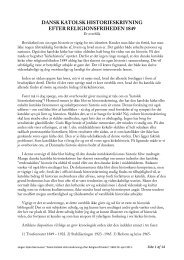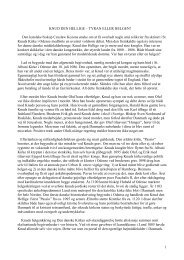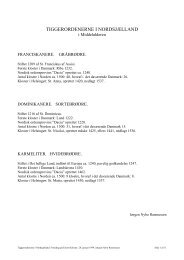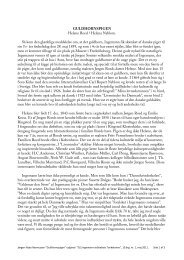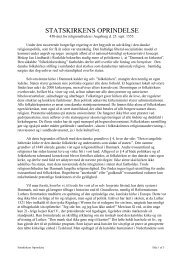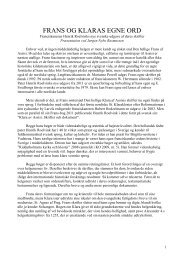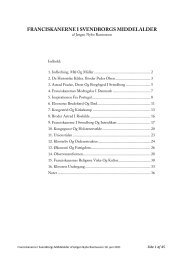PETRUS OLAI - Jørgen Nybo Rasmussen
PETRUS OLAI - Jørgen Nybo Rasmussen
PETRUS OLAI - Jørgen Nybo Rasmussen
Create successful ePaper yourself
Turn your PDF publications into a flip-book with our unique Google optimized e-Paper software.
AUTHOR<br />
<strong>PETRUS</strong> <strong>OLAI</strong> (OFM) by <strong>Jørgen</strong> <strong>Nybo</strong> <strong>Rasmussen</strong><br />
<strong>PETRUS</strong> <strong>OLAI</strong> (OFM)<br />
by <strong>Jørgen</strong> <strong>Nybo</strong> <strong>Rasmussen</strong><br />
Petrus Olai (Peder Olsen) was a Danish Franciscan Friar ca. 1490 - ca. 1570, whose historical<br />
works in many respects build a bridge between medieval and modern historiography. Most dates of<br />
his life must be concluded from his manuscripts.<br />
The personal inscription on the inside of the cover of his ”Collectanea ad historiam danicam<br />
pertinentia” reveals his identity: ”Petro Olavo Saneropio Minoritano”. Sonnerup is a parish between<br />
Holbæk and Roskilde.<br />
As a young man he must have entered the Franciscan Friary in Roskilde, where he seems to have<br />
stayed during the greater part of his life, also after the dissolution of the convent by the<br />
Reformation. – Lyschander ca. 1620 called him ”Petrus Olai Roschildensis” and mentions, that in<br />
his older days his subsistance in Roskilde was guaranteed by the nobleman and naval hero Herluf<br />
Trolle.<br />
The inscription of the later historiographer Anders Sørensen Vedel on Coll. fol. 171v testifies the<br />
destiny of the manuscript: ”Dom. Petrus Olai, previously of the Franciscan Order, has with great<br />
diligence composed this book from various sources, and by his death handed it over to me as a<br />
memory”. This must have happened about ca. 1570. - His ” Danorum Gesta post Chronica Saxonis<br />
facta” must have been written in his later years, but can only through analysis of style and content<br />
be identified as his work.<br />
Inside this framework further details of his life can be concluded from a codicological analysis of<br />
”Collectanea”, above all from his treatise on the history of the Franciscan Order in sheet 10 = Coll.<br />
fol. 103-126 (<strong>Rasmussen</strong> 1976). Ca. 1515 the young friar Peder Olsen seems to have begun his<br />
”Collectanea” as a notebook for copies and extracts of older sources about Danish history.<br />
From ca. 1522 his historiographical interests and abilities were taken into service by his order, as<br />
his superiors entrusted him to write a cronicle about the progress and victory of the observantine<br />
reform-movement among the Danish Franciscans from 1468 - 1522, supplementing it with a list of<br />
the provincial ministers of the provinca ”Dacia” etc.<br />
Throughout the following years of growing crisis for the Catholic Church and also for the<br />
Franciscan Order, friar Peder increased his work with contributions about Franciscan bishops, lists<br />
of chapters of the province ”Dacia” and ca. 1533 with an important section about the foundation of<br />
all Franciscan convents in ”Dacia”, including Denmark, Norway and Sweden.<br />
With the legal dissolution of the mendicant orders in Denmark 1537 further work on this subject<br />
got meaningless and stopped. His work about Danish history was however continued until ca.<br />
1560, and bore fruits in his second work: ”Danorum Gesta”. The authorship of the Danish excerpt<br />
of DG, ”Roskilde-årbogen”, is unknown.<br />
WORKS<br />
1) Ms. ”Collectanea ad historiam danicam pertinentia” AM 107,8 o. = Collections concerning<br />
Danish history. (172 folia)<br />
1
2) Ms. ”Danorum Gesta post Chronica Saxonis facta” = UBB de la Gardie 37 fol. = Acts of the<br />
Danes after Saxos Chronicle (86 folia) or ”Paraleipomena chronicorum” Gl.KS 2461,4 o =<br />
Excerpts of the Cronicles (92 folia).<br />
These manuscripts have never been edited as a whole. ”Collectanea” is as mentioned a notebook<br />
with a very complicated codicological and textual structure (<strong>Jørgen</strong>sen 1920, <strong>Rasmussen</strong> 1976).<br />
The little volume for historical notes, copies and excerpts has when needed successively been<br />
supplemented with extra pages or loose slips. The texts often consist of an original layer<br />
supplemented with additions between the lines and in the margins, and are in some cases not in<br />
Peder Olsens own hand. This character of ”Collectanea” as an aid or a tool for further studies<br />
has made the work of the editors extremely difficult, and their editions are not always<br />
satisfactory. – The ”Danorum Gesta” is at the other hand a well composed and coherent text,<br />
treating the Danish history from 1191 – 1559. But is has been left forgotten and almost unedited<br />
with the doubtful motive, that it mainly consists of materials, already known from other sources!<br />
From ”Collectanea” J. Langebek and the other editors of ”Scriptores rerum danicarum” selected<br />
and edited different fragments and in the most cases invented their titles. This work was in the<br />
20. Century continued by the editors of mediæval annals, Ellen <strong>Jørgen</strong>sen and Erik Kroman.<br />
POs contributions to the history of the Franciscan Order was edited a second time by M. Cl.<br />
Gertz in ”Scriptores minores”. A little fragment of ”Danorum Gesta” and the whole of its<br />
Danish popularization, ”Roskilde-årbogen”, was in the 19. Century edited by H.F. Rørdam. –<br />
In the following the partial editions of ”Collectanea” are first mentioned in their chronological<br />
order with a roughly indication of their place in the manuscript. But this is only meant as a<br />
survey; detailed problems cannot be discussed here.<br />
1. ”Series et brevior historia regum Danie” SRD I, 1772, 64-68 = Coll. fol. 38. – Cfr. edition<br />
by Gertz = nr. 16.<br />
2. ”Chronica regum danorum , a Dano ad obitum Johannis regis”. SRD I, 1772, 68-148 = Coll.<br />
fol. 1-39 and 68-91 (with many omissions and without the marginal notes)<br />
3. ”Annales rerum danicarum a Cimbrorum exitu ad An. Chr. 1541”. SRD I, 1772, 171-197 =<br />
Coll. 9-39 and 68-91 (insertions and marginal notes).<br />
4. ”Anonymi Roskildensis Chronica Danicum ab An. 826 – 1157”. SRD I, 1772, 373-387 =<br />
Coll. fol. 145-159 (copy by P.O.) – New edition by Gertz, vgl. Nr. 15.<br />
5. ”Excerpta Normannica et Danica ab An. 841 ad 1050”. SRD II, 1773, 10-17 = Coll. fol. 33-<br />
34 and 36 (partially).<br />
6. ”Excerpta ex historicis Danorum, a Suenone Tiugskæg ad Ericum Menved”. SRD II, 1773,<br />
203 - 265 = Coll. fol. 40-66.<br />
7. ”Historia Martyrizationis S. Kanuti regis”. SRD III, 1774, 322-325 = Coll. fol. 8-9. Cfr.<br />
commentaries by Gertz in: Vita Sanctorum Danorum, 1912, 51-53.<br />
8. ”Historia de inchoatione et propagatione ordinis fratrum minorum in Dania et regionibus<br />
septentrionalibus”. SRD V, 1783, 511-528 = Coll. fol. 106-121. - Cfr. edition by Gertz, Nr.<br />
17.<br />
9. ”Historia mirabilium in Ecclesia B. Petri Slesvici factorum”. SRD V, 1783, 581-582 = Coll.<br />
fol. 75.<br />
<strong>PETRUS</strong> <strong>OLAI</strong> (OFM) by <strong>Jørgen</strong> <strong>Nybo</strong> <strong>Rasmussen</strong><br />
2
10. ”Archiepiscopi Hamburgenses”. SRD VI, 1786, 608-610 = Coll. fol. 94-96.<br />
11. ” Frustrum chronici Episcoporum Lundensium”. SRD VI, 1786, 638-639 = Coll. fol.81?<br />
12. ”Episcopi Roschildenses”. SRD VII, 1792, 152-155 = Coll. fol. 102.<br />
13. ”Duodecim excellentiæ regni Daciæ”. SRD VIII, 1834, 493-502 = Coll. fol. 133-139.<br />
14. ”De S. Erico rege Danorum” in M. Cl. Gertz: ”Vitæ Sanctorum Danorum” 1908-1912, 423-<br />
424 = Coll. 72. Ibd. 434-35 = Coll. 64-65.<br />
15. ”Chronica Roschildense” M. C. Gertz: ”Scriptores minores historiæ danicæ medii ævi” I,<br />
1918, 14-33. (Among other copies also POs) = Coll. fol. 145-159.<br />
16. ”Series et brevior historia regum Danie”. M. Cl. Gertz in Scr. Min. I, 1918, 161-166 = Coll.<br />
fol. 38.<br />
17. ”De ordine fratrum minorum”. M. Cl. Gertz in Scr. Min. II, 1922, 279-324 = Coll. fol. 103-<br />
121.<br />
18. ”Franciskanermunken Peder Olsens Collectanea”. Ellen <strong>Jørgen</strong>sen: ”Annales Danici medii<br />
ævi”, 1920, 203-211. (Selected texts from Coll. which seem to originate from lost medieval<br />
Works)<br />
19. ”Annales Dano-Svecani 826-1415”. E. <strong>Jørgen</strong>sen, Ann. Dan. 1920, 130-131.= Coll. fol 39c,<br />
50, 61bis, 62, 64 and 66-67. (This text was known and partially copied by PO) Cfr. new<br />
editions by Erik Kroman, Danmarks middelalderlige annaler, 1979, 300-306 and by Göte<br />
Paulsson, Annales suecici medii ævi, Lund 1974, 374 ff.<br />
20. ”Provinciale Ordinis fratrum minorum” by S. Cavallin in Bland latinska inskrifter i Ystads<br />
klosterkyrka, Skrifter utgivna av Ystads fornminnesförening VII, Ystad 1957, 58- 59. =<br />
Coll. fol. 112.<br />
21. Introduction to the Danish Rhyme-Chronicle (Fortalen til den danske rimkrønike) by Helge<br />
Toldberg: Den danske rimkrønike, 1961, 4-6 = Coll. 97-98.<br />
22. Memorial-tablet of the Greyfriars Church in Odense (Odense-tavlen). J. <strong>Nybo</strong> <strong>Rasmussen</strong>,<br />
Broder Peder Olsen, 1976, 159 = Coll. 109r. (POs text edited and compared with Lorez<br />
Widows text from 1623)<br />
23. From the ”Danorum Gesta post chronica Saxonis facta (1191-1559) ” only fragments<br />
treating the periods 1241-1275 and 1552 – 1559 are edited by H.F.Rørdam in Monumenta<br />
historiæ Danicæ 2. rk. 2. 1887, 1-33.<br />
24. ”Roskildeårbogen fra 1448-1549”, the abridged Danish excerpt of ”Danorum Gesta” from<br />
the 16. century, was edited by H.F.Rørdam in: Monumenta historiæ danicæ 1. rk. 1, 1873,<br />
297-381.<br />
The two manuscripts of ”Danorum Gesta” contain the same text with the exception, that UUB<br />
de la Gardie Nr. 37 fol. begins with the year 1191, but Gl.Kgl. Saml. 1461,4o with 1319. None of<br />
them exist in Petrus Olais own hand, they are contemporary anonymous copies. Though the greater<br />
part of the text are copies from texts in ”Collectanea” , there are also other insertions, so from the<br />
Skiby-chronicle. ”Danorum Gesta” in fact represents the friars own systematic synthesis of his<br />
diligent collecting activities during his youth. The work must justly be evaluated as the first<br />
essential essay to create the ”Continuation af Saxo”, which was later realized by Arild Hvidtfeldt It<br />
therefore deserves a better historiographic appreciation than the actual almost contemptous silence.<br />
<strong>PETRUS</strong> <strong>OLAI</strong> (OFM) by <strong>Jørgen</strong> <strong>Nybo</strong> <strong>Rasmussen</strong><br />
3
The influence of the two works were very different. Already in the lifetime af Petrus Olai<br />
”Collectanea” was used by contemporary historians. It has been made credible, that the Carmelite<br />
friar and Catholic apologetic, Paulus Heliæ, also used it as a source for his ”Skiby-chronicle”<br />
(Bøggild–Andersen 1956). The first historian after the Reformation, Hans Svaning, took so much<br />
advantage of the works of Petrus Olai, that they has been called the main source for his description<br />
of the kings Hans and Christian II (<strong>Jørgen</strong>sen 1931). After having aquired ”Collectanea” at the<br />
death-bed of friar Petrus and also as the owner of the Ms. ”Paraleipomena Chronicorum”, Anders<br />
Sørensen Vedel used them both for his historiography. Some informations by Cornelius Hamsfort<br />
must also derive from the history of the Danish franciscans in ”Collectanea”. But about 1600 the<br />
manuskript dieappeared, until it 1726 was aquired by Arne Magnusson, and Langebek 1772 began<br />
the editions in SRD.<br />
The ”Danorum Gesta” had a wider influence in older times and exist besides the two here<br />
mentioned manuscripts in several other copies. Its greatest influence owed to the fact, that its later<br />
part – concerning the period 1448-1559 – in an abridged version was tranlated into Danish as the<br />
”Roskilde-annual” (Roskilde-årbogen) . According to its editor ( H.F.Rørdam 1873) Roskildeårbogen<br />
was copied so often in the 16. century, that – despite the fact, that it was not printed – it<br />
besides Rimkrøniken seems to have been the most wide-spread account of the later Danish history<br />
in this century and remained so until the edition af the ”Danske Krønike” by Arild Hvidtfeldt 16oo.<br />
BIBLIOGRAPHY<br />
An exhaustive biography of Petrus Olai has until now not been written. Dispersed contributions to<br />
his bio-bibliography can be found in the introductions and commentaries to many of the the already<br />
mentioned editions, above all by J. Langebek in SRD, and by H.F. Rørdam, Ellen <strong>Jørgen</strong>sen and<br />
M.Cl. Gertz.<br />
Short biographies: H.F.Rørdam in Dansk biografisk Leksikon 1. ed. vol. 8, 1899, 437-438 and Ellen<br />
<strong>Jørgen</strong>sen ibd. 2. ed. vol. 17, 1939, 447 and 3. ed. vol 8, 1975, 45. Also Ingvar Andersson in<br />
”Kulturhistorisk leksikon for nordisk middelalder” vol. 12, 1967, col. 265-266. -- ”Collectanea is<br />
described in ”Katalog over den arnamagnæanske håndskriftsamling”, vol. 2, 1894, 395. – POs<br />
franciscan historiography is shortly treated in Johs. Lindbæk: ”De danske franciskanerklostre”,<br />
1914, 258-260, and his contributions to Danish history by Ellen <strong>Jørgen</strong>sen in: ”Historieforskning og<br />
historieskrivning i Danmark indtil år 1800”, 1931, 82-85, and by C.O.Bøggild-Andersen: ”Studier<br />
over Poul Helgesen. Nogle Skibykrønike-problemer” in Historisk tidsskrift 11. rk. vol. 5, 1956, 1-<br />
109. An analysis of his treatment of the Franciscan Order is made by <strong>Jørgen</strong> <strong>Nybo</strong> <strong>Rasmussen</strong>:<br />
”Broder Peder Olsen som de danske franciskaneres historieskriver” = Skrifter udgivet af det<br />
Historiske Institut ved Københavns Universitet nr. 6, 1976.<br />
<strong>PETRUS</strong> <strong>OLAI</strong> (OFM) by <strong>Jørgen</strong> <strong>Nybo</strong> <strong>Rasmussen</strong><br />
4



